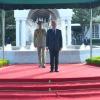Dear Madhu ji,
I was very excited when I learned you were coming to Ahmedabad and I was honoured that you expressed interest in possibly meeting with me.
I was sitting with a journalist friend when I read your Tweet about visiting Ahmedabad and he told me you are a “pioneering feminist who did ground breaking work.” He also told me that in 2005 you signed a very strong petition calling for Gujarat Chief Minister Narendra Modi’s dismissal because of Modi’s role in the 2002 Gujarat riots. He also added that you have been very vocal on behalf of Kashmiri Pandits. After I witnessed the Gujarat riots in 2002, I returned to the United States—where I was born and raised—and I gave lectures for six months about the violence I saw. In each lecture, an audience member would inevitably shout at me that I have ignored the plight of the Kashmiri Pandits. It is true. I know very little about Kashmir, and for that matter Kashmiri Pandits, and I would have enjoyed and benefited from listening to your views on the conflict there.
I understand from your Twitter feed that you have left Ahmedabad. I know your days in Ahmedabad were limited and I fully understand that you were not able to meet. Therefore in this letter I will try to convey some of the things I had hoped to tell you in person, in particular about your Tweets.
I am pleased that you have enjoyed your stay in Ahmedabad. To quote some of your remarks:
@madhukishwar: Friends say auto rickshaws never refuse passengers, never over charge in Ahmadabad or elsewhere in Gujarat. Why are Delhi autos lawless?
@madhukishwar: Photographs of young men and women past mid night having soda in Ahmedabad. Young men don’t have menacing presence
@madhukishwar: North Indian friends I’m staying with in Ahmedabad took me for midnight drive to see how safe is gujarat for women- even on highway.
@madhukishwar: I am out on Ahmedabad streets past 1 am enjoying uniquely satvic nightlife of Gujarat. Will write more about it
Indeed, Gujaratis are exceptional with their hospitality and kindness. As a Gujarati whose grandparents are from Kutch, I am pleased you feel welcome here.
But I take exception to your comment that women are safe in Gujarat or that “young men don’t have menacing presence.”
According to the National Crime Bureau, the number of rapes in Gujarat increased from 408 cases in 2010 to 439 in 2011. When we look at other forms of violence like dowry deaths, this number becomes more staggering.
From the Indian Express, March 28, 2008:
In a span of twelve years, more than 50,000 cases of violence against women have been reported from 12 districts of Gujarat. With 640 dowry deaths and 1,443 rape cases, the chart is topped by a staggering 14,998 cases of cruelty by husband and in-laws, followed by accidental deaths which is pegged at 14,631.
The article cites a report from an NGO called Navsarjan that conducted research in 12 districts in Gujarat during a twelve year period (1995-2007). According to the report, “7894 women committed suicide and 3,006 women were abducted during this period in these districts.”
In a December 28, 2012 story, DNA reported that in Gujarat only 1 out of 5 got life term for rape and that in over 50% of the cases, the rapist had to serve only 6 to 10 years in prison. Just this week, IBN-Live reported that an ex-MLA’s nephew and three friends gang raped a girl for over three years.
I recognize that these numbers might be better than other states in India but the statistics show that violence against women in Gujarat is increasing.
At a forum I attended this weekend sponsored by Apna Adda called “Rape and Me,” female students from various universities in Ahmedabad said they no longer feel comfortable going out alone or with only girls at night. One said she had faced so much sexual harassment in Gujarat that she is now advising girls to take self-defence classes. Another young woman told me that at her college an elderly man flashed his genitals to her on three occasions. She said she rarely goes out past dark alone for fear of these incidents happening again.
Parents at this forum on Saturday—many of whom were born and raised in Ahmedabad—said Gujarat was not always like this and that it is getting progressively worse. I am happy that you felt comfortable staying out as a woman at 2 am. In my two years of research, I have met very few women in Gujarat who would say the same.
*
However the main reason I write to you, Madhu ji, is to take issue with your Tweets about the “inclusive development of Gujarat”. Some of your tweets:
@madhukishwar: Modi sure knows how to address and strengthen self esteem of his people. Give hope and confidence
@madhukishwar: 2\4 If I as much as say Gujarat roads are best in country, see Modi’s inclusive development for urself I become political untouchable. Why?
@madhukishwar: Those upset at my Gujrat observations: challenge me on facts. Don’t hurl ideology or prejudice at me. I’ll be 1st to apologise 4 inaccuracy
Since you have requested facts, here are some to consider.
In an article in the Business Standard, Mihir Sharma takes issue with the notion that Gujarat is growing at a much faster rate than other states. He writes:
…between 2004 and 2012, Gujarat’s GDP growth left the national average, 8.3 per cent, far behind. It grew at 10.1 per cent. But, in the same period, Maharashtra grew at 10.8 per cent and Tamil Nadu at 10.3 per cent.
Sharma acknowledges that Gujarat has grown faster during the period of Modi’s rule but its rate of growth has not been as impressive as in other states:
Gujarat in 2004-12 grew 3.6 per cent faster than it did in 1994-2002. Meanwhile, Bihar grew 6.5 per cent faster, if from a lower base. But better-off Maharashtra’s growth was 5.8 per cent faster in that period, and Tamil Nadu’s was 4.7 per cent.
As a resident of Ahmedabad, I have seen much of the progress myself, something Sharma acknowledges in his piece. But should Modi be given credit for Gujarat’s successes yet be given a clean sheet for the state’s failures? Sharma notes:
Still, is this chief minister somehow special? The evidence seems indisputable that Gujarat’s bureaucracy is responsive, decentralised and innovative. It is possible that Mr Modi is somehow personally responsible for this; Professor Debroy says to deny him all credit would be unfair and uncharitable. I agree. Though I do note that less objective observers of Mr Modi than Professor (Bibek) Debroy are hypocritically happy to suggest that he is individually responsible for the emplacement of every handpump in north Gujarat, but somehow had nothing whatsoever to do with the complete failure of the entire state machinery in 2002.
In an article in Rediff, Shivam Vij writes cautions against simple explanations of Gujarat’s growth. He writes:
Look at the per capita net state domestic product, a better indicator of prosperity than the mere rate of growth. Gujarat has been occupying 6th or 7th rank on this list since the early ’70s and it’s not as if Narendra Modi’s leadership made Gujarat jump up to the top end of the list.
Given your claim of “inclusive” development in Gujarat, I want to point out to you some more numbers:
According to a study by Rakesh Basant of the IIM Ahmedabad University entitled “Education and Employment among Muslims in India: An Analysis of Patterns and Trends,” he concludes that Muslims carry a double burden of being labeled as “anti-nationalists” and being appeased at the same time.
But he cautions us to think that the “appeasements” have helped Muslims in any way. He states:
The fact that the so-called appeasement has not resulted in any benefits is typically ignored. Identity markers often lead to suspicion and discrimination by people and institutions. Discrimination too is pervasive in employment, housing and education. Gender injustice is usually identified purely with personal law to the exclusion of gender-related concerns in education and employment that Muslim women do face on a continuing basis.
Basant acknowledges that while education rates for Muslims in Gujarat remain woefully low, the trends show that Muslims are improving in this category. But this is stymied, he argues, by “identity based discrimination (which) reduces access, enhances inequity and adds to insecurity.”
This inequity exists in other areas of life too. In an article in the New York Times, Hartosh Singh Bal writes that “Gujarat has an urban poverty ratio of almost 18 percent, compared with almost 21 percent for the country as a whole.” According to Bal, “42.4 percent of the Muslims in urban Gujarat are poor, compared with 33.9 percent of Muslims in urban India overall.” Bal illustrates the disenfranchisement of Muslims in Gujarat by citing the refusal of the Narendra Modi government to release 53,000 scholarships for Muslim students. Vij writes in his Rediff piece that “Gujarat is the only state to not have implemented central government scholarships for students from minority communities, started in 2008.”
Indeed in my neighborhood of Juhapura, often called one the largest ghettoes of Muslims in India, there are only four high schools for a population of 300,000. Of these four high schools, one is private, two are partly aided (ie the teachers salary is provided by the state) and only one is fully aided up to the 12th standard.
VK Tripathi, an IIT Delhi Physics professor, has been coming to Juhapura, the Muslim ghetto of Ahmedabad, every two months since 2007 to fight for schools. In a 2009 article in the Times of India, Tripathi says there were only “24 educational institutions for a population of more than 3.5 lakh.”
Most schools in Juhapura do not have paved roads, let alone enough class rooms, and Tripathi has been fighting the Gujarat government to provide better educational opportunities for residents of Juhapura. I saw Tripathi sahib just last weekend in Juhapura and he told me that while there is some progress, it is still “abysmally low”.
Muslims do not just lag behind in education. In an article in Outlook magazine in 2011 by Pragya Singh, she cites statistics from the Sachar Committee Report and the NSSO (61st round) that state that urban poverty among Muslims in Gujarat is 800% higher than upper caste Hindus; 50% higher than OBCs. Rural poverty among Muslims is 200% more than Hindus and about 60% of Muslims live in urban areas.
Citing research by Abusaleh Shariff for International Food Policy Research Institute (IFPRI), Singh says that Gujarat’s high levels of hunger are akin to Bihar, Orissa, and Maharashtra, and Karnataka. Singh writes that “Gujarat’s Muslims are most likely to be self-employed where wages have increased the least,” and that “Muslims are least likely to get organized sector and salaried jobs”.
For Shariff, who conducted extensive research on Gujarat’s Muslims, the explanation is straight forward: “The economic and social life of Gujarati Muslims is worse than in some least developed states. The reason is discrimination.”
*
I could continue to cite statistics but as one of India’s most accomplished social scientists, you know far more reports and statistics than I do.
What I really want to do in this letter is to explain what I would have shown you in Ahmedabad.
I would have taken you to Siddiqabad, a colony of about 200 homes built for survivors of the Gulbarg and Naroda Patiya massacre. Siddiqabad is tucked behind the main road in Juhapura just down the street from my flat. Siddiqabad was meant to be temporary housing for riot victims. But it has been ten years and residents have grown weary of promises that they will get regular electricity, a gutter line, or access to a school nearby.
I would have taken you to Narol (Bombay Hotel), a row of homes occupied by survivors of the Naroda Patiya massacre. Narol is next to a massive trash dump and the builder, a Muslim, told me no one else wanted to sell land to him after the 2002 riots. Each year during the monsoon, water runs from the trash dump into people’s homes. As a result, children in Narol have grown up with deformities. When I visited, a young boy of about 12 years interrupted his cricket game to talk with me. “Yes we see dead bodies here all the time,” he said casually as he tossed a ball into the air.
I would have taken you to Vastrapur, where I lived last year for six months in an all Hindu building. My friend said I could live there on one condition: I could not use my real name. It was humiliating. It was also in Vastrapur where my friend Nida Yamin, an IIM research associate from Delhi, was recently denied housing because she is a Muslim. She left Ahmedabad after just a few months. “This place,” she told me, “is not for us.”
I would have introduced you to Asif bhai, the director of the Crescent School in Juhapura who built his school in 2008 because he realized that the Gujarat government was never going to build adequate schools for Muslims.
I would have introduced you to Kiran Uncle, a tireless advocate for secularism who has fought both Hindu and Muslim communalism and has been ostracized from his family for speaking out so vociferously for Muslims after the 2002 riots.
I would have introduced you to Hemanshu Uncle, a restaurant owner in Ahmedabad. He tells me that every day someone comes into his restaurant and criticizes him for serving non-vegetarian food. Sometimes they tell him he is a bad Brahmin and he has grown tired of the “holier than though attitude of Gujaratis.” This is not the Gujarat, he tells, that he experienced in his childhood. It was more tolerant then.
I would have introduced you to Sheba ji, a remarkable advocate for women’s rights in Gujarat who has been working tirelessly to address Gujarat’s rising problem of violence against women. I would have introduced you to Sheba ji’s staff, many of whom themselves are survivors of domestic violence.
I would have introduced you to Pravin bhai, a film maker who has conducted extensive interviews with farmers in Gujarat who tell him farmer suicides are on the rise in this state.
I would have introduced you to Jila, a 24 year old Ahmedabadi who was displaced in the 1992 and the 2002 riots. She still hopes to live in a Gujarat where people don’t always look at her as a Muslim first.
*
Of course I know, Madhu ji, that you have met many Muslims here and I commend you for that. You mentioned businessman Zafar Sareshwala in one of your Tweets. Zafar bhai is a friend and I have no interest in criticizing him or anyone else. But I will say this: it has taken me an awful amount of time to get Muslims to open up about their experiences in Gujarat. When I first started conducting research in 2011, most of the Muslims I met told me that everything was great and that they have moved on.
But as I spent more time with them, as I shared my own horror story of watching mobs attack people in 2002, as I spoke about the depression that I plummeted in for years after the riots, as I talked about the counseling I went through to help me cope with the memories of dozens of women who shared their stories in the relief camps of being rapedduring the 2002 riots, then people gradually—and very slowly—people start telling me their own stories. But it has taken long, two years actually, to get to this point.
Gujarati Muslims are often afraid to say what they really think about Gujarat or Narendra Modi. In Gujarat, Modi has become a “god” for so many—given all the Muslims face in Gujarat, why should a Muslim face further isolation by criticizing Modi or life in Gujarat? I hear this all the time: “Zahir you can criticize Modi or the Gujarat state because you do not have family here. But for us, our life will become hell if we speak out.”
And yet the outrage, the anger of Gujarat’s Muslims is there in the pauses, in the things they are afraid to say, in the silent articulation of their faces.
Last year I interviewed a BJP Muslim politician, whose name I will withhold, and he kept praising Modi. I try to speak to everyone I can and his story was equally important to me. As we pulled out of his drive way, his car got stuck on his unpaved road outside his home in Juhapura. He pulled out his phone and called his friend in the government.
“About that paved road. Is it coming?” he asked. I could not hear the response on the other hand. When the BJP politician hung up the phone, he could no longer make eye contact with me. Two years later he still does not have a paved road.
*
I wish I could write more but there is no electricity in my flat in Juhapura right now and I am writing this sitting on charpai outside my building, trying to catch some light from my neighbor’s generator powered well lit bungalow. I have not had regular running water for the past two days (the same happened last weekend) and when I told my society manager, he told me “yeh hai Juhapura.”
That seems to be the root problem here in Gujarat: Muslims—and so many others in this state—have come to accept less, to ask for less, to be content with less, and then told by society that they should complain less.
I know you Tweeted that such problems do not exist in Gujarat.
@madhukishwar: 8\9 Modi doesn’t rest. Already every rural urban household has 24×7 power, most hv high quality piped water. But guj govt working on further
@madhukishwar: 9\9 Gujrat working on amazing improvements in water policy. It was water scarce state, today it is water surplus with water table rising
Perhaps we will have a chance to meet in the future and you can show me this Gujarat: where Muslims do not face prejudice, where women do not report that sexual harassment is increasing, where farmers do not feel that their livelihood is being threatened.
Yes, some people do indeed have more after Modi. But many others do not. This profound inequity upsets me, not because I am a Muslim, but because I love Gujarat and my Gujarati people and I would not be writing this letter if I did not want more for Gujarat and all its people.
My invitation is still open to you, Madhu ji. I have emailed you my mobile number and it would indeed be an honor to meet you and to meet you in Ahmedabad.
With fondness and respect,
Zahir Janmohamed,
Juhapura,
















